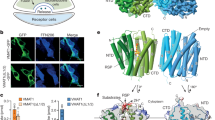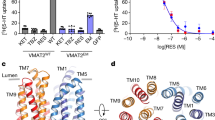Abstract
Monoamine oxidase B (MAO B) is a mitochondrial outermembrane flavoenzyme that is a well-known target for antidepressant and neuroprotective drugs. We determined the structure of the human enzyme to 3 Å resolution. The enzyme binds to the membrane through a C-terminal transmembrane helix and apolar loops located at various positions in the sequence. The electron density shows that pargyline, an analog of the clinically used MAO B inhibitor, deprenyl, binds covalently to the flavin N5 atom. The active site of MAO B consists of a 420 Å3-hydrophobic substrate cavity interconnected to an entrance cavity of 290 Å3. The recognition site for the substrate amino group is an aromatic cage formed by Tyr 398 and Tyr 435. The structure provides a framework for probing the catalytic mechanism, understanding the differences between the B- and A-monoamine oxidase isoforms and designing specific inhibitors.
This is a preview of subscription content, access via your institution
Access options
Subscribe to this journal
Receive 12 print issues and online access
$189.00 per year
only $15.75 per issue
Buy this article
- Purchase on Springer Link
- Instant access to full article PDF
Prices may be subject to local taxes which are calculated during checkout




Similar content being viewed by others
Accession codes
References
Mitoma, J. & Ito, A. J. Biochem. 111, 20–24 (1992).
Cesura, A.M. & Pletscher, A. Prog. Drug Res. 38, 171–297 (1992).
Fowler, C.J., Wiberg, A., Oreland, L., Marcusson, J. & Winblad, B. J. Neural Transm. 49, 1–20 (1980).
Boulton, A.A. et al. Catacholamines. Bridging basic science with clinical medicine. (eds Goldstein, D.G., Eisenhofer, G. & McCarty, R.) 308–311 (Academic Press, New York; 1998).
Vindis, C., Seguelas, M-H., Bianchi, P., Parini, A. & Cambon, C. Biochem. Biophys. Res. Commun. 271, 181–185 (2000).
Saura, J. et al. Neuroscience 62, 15–30 (1994).
Chiba, K., Trevor, A. & Castagnoli, N. Jr Biochem. Biophys. Res. Commun. 120, 579–585 (1984).
Fowler, J.S. et al. Nature 379, 733–736 (1996).
Fraaije M.W. & Mattevi, A. Trends Biochem. Sci. 25, 126–132 (2000).
Holm, L. & Sander, C. J. Mol. Biol. 233, 123–138 (1993).
Pawelek, P.D. et al. EMBO J. 19, 1–13 (2000).
Binda, C. et al. Structure 7, 265–276 (1999).
Newton-Vinson, P., Hubalek, F. & Edmondson, D.E. Protein Expr. Purif. 20, 334–345 (2000).
von Heijne, G. J. Mol. Biol. 225, 487–494 (1992).
Ulmschneider, M.B. & Sansom, M.S.P. Biochim. Biophys. Acta 1512, 1–14 (2001).
Rebrin, I., Gehai, R.M., Chen, K. & Shih, J.C. J. Biol. Chem. 276, 29499–29506 (2001).
Walker, M.C. & Edmondson, D.E. Biochemistry 33, 7088–7098 (1994).
Miller, J.R. & Edmondson, D.E. Biochemistry 38, 13670–13683 (1999).
Trickey, P. et al. Biochemistry 39, 7678–7688 (2000).
Nandigama, R.K., Miller, J.R. & Edmondson, D.E. Biochemistry, ASAP article (2001).
Wu, H.-F., Chen, K. & Shih, J.C. Mol. Pharmacol. 43, 888–893 (1993).
Geha, R.M., Rebrin, I., Chen, K. & Shih, J.C. J. Biol. Chem. 276, 9877–9882 (2001).
Leslie A.G. Acta Crystallogr. D 55, 1696–1702 (1999).
Collaborative Computational Project, Number 4 Acta Crystallogr. D 50, 760–767 (1994).
Sheldrick, G.M. Direct methods for solving macromolecular structure (ed. Fortier, S.) 131–141 (Kluwer Academic Publishers, Dordrecht; 1998).
Tong, L. & Rossmann, M.G. Methods Enzymol. 276, 594–611 (1997).
Navaza, J. Acta Crystallogr. A 50, 157–163 (1994).
Cowtan, K. & Main, P. Acta Crystallogr. D 54, 487–593 (1998).
Jones, T.A., Zou, J.Y., Cowan, S.W. & Kjeldgaard, M. Acta Crystallogr. A 47, 110–119 (1991).
Murshudov, G.N., Vagin, A.A. & Dodson, E.J. Acta Crystallogr. D 53, 240–255 (1997).
Kleywegt, G.J. & Jones, T.A. Acta Crystallogr. D 50, 178–185 (1994).
Kraulis, P.J. J. Appl. Crystallogr. 24, 946–950 (1991).
Esnouf, R.M. Acta Crystallogr. D 55, 938–940 (1999).
Philippsen, A. DINO: Visualizing Structural Biology, http://www.dino3d.org (2001).
Laskowski, R.A., MacArthur, M.W., Moss, D.S. & Thornton, J.M. J. Appl. Crystallogr. 26, 283–291 (1993).
Acknowledgements
This work was supported by grants from the National Institute of General Medical Sciences of the NIH, the Consiglio Nazionale delle Ricerche and Agenzia Spaziale Italiana. We thank the staff of the EMBL/DESY and ESRF facilities for help during the data collection. The European Union provided support through the Human Capital Mobility Program to Large Scale Installations Project. We thank A. Coda, B. Curti, M. Rizzi and R. van den Heuvel for helpful discussions.
Author information
Authors and Affiliations
Corresponding authors
Rights and permissions
About this article
Cite this article
Binda, C., Newton-Vinson, P., Hubálek, F. et al. Structure of human monoamine oxidase B, a drug target for the treatment of neurological disorders. Nat Struct Mol Biol 9, 22–26 (2002). https://doi.org/10.1038/nsb732
Received:
Accepted:
Published:
Issue Date:
DOI: https://doi.org/10.1038/nsb732
This article is cited by
-
Design of new reversible and selective inhibitors of monoamine oxidase A and a comparison with drugs already approved
Bulletin of the National Research Centre (2023)
-
Recent updates on structural insights of MAO-B inhibitors: a review on target-based approach
Molecular Diversity (2023)
-
Monoamine oxidase A-dependent ROS formation modulates human cardiomyocyte differentiation through AKT and WNT activation
Basic Research in Cardiology (2023)
-
Molecular docking/dynamics simulations, MEP analysis, bioisosteric replacement and ADME/T prediction for identification of dual targets inhibitors of Parkinson’s disease with novel scaffold
In Silico Pharmacology (2023)
-
Modulation of histone H3K4 dimethylation by spermidine ameliorates motor neuron survival and neuropathology in a mouse model of ALS
Journal of Biomedical Science (2022)



